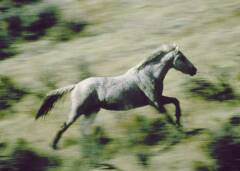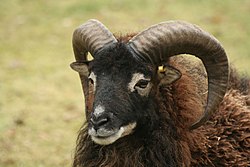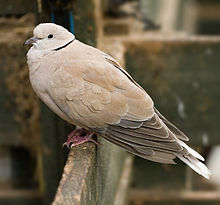Feral: Difference between revisions
→External links: wrong link. Russian page is about animals in city |
No edit summary |
||
| Line 108: | Line 108: | ||
[[fr:Marronnage (animaux)]] |
[[fr:Marronnage (animaux)]] |
||
[[id:Organisme meliar]] |
[[id:Organisme meliar]] |
||
[[ru:Бездомные животные]] |
|||
[[sv:Förvildning]] |
[[sv:Förvildning]] |
||
Revision as of 12:46, 9 March 2009


A feral organism is one that has escaped from domestication and returned, partly or wholly, to its wild state. The introduction of feral animals or plants, like any introduced species, can disrupt ecosystems and may, in some cases, contribute to extinction of indigenous species.
Definitions
In addition to the meaning of the word feral described here, from Latin fera, "a wild beast", the word has a second unrelated meaning, from Latin feralis, "belonging to the dead", "funeral". [1].
Animals
The dictionary definition of a feral animal is one which has escaped from a domestic or captive status and is living more or less as a wild animal. Zoologists generally exclude from the ‘feral’ category animals which were genuinely wild before they escaped from captivity: neither lions escaped from a zoo nor the sea eagles (Haliaeetus albicilla) recently re-introduced into the UK are regarded as 'feral'. As far as animals are concerned, this article assumes the ‘zoological definition’ of feral. Some common examples of animals with feral populations are goats, cats, and pigs.
The term 'feral' should not be used to describe the naturalization of a wild (i.e. non-domesticated) species.[2]. Nor should ‘feral’ be used to describe a population of a species which although descended from a domesticated population has severed itself from dependence on humans and lived independently in the wild for a long period.[3]
Plants
Domesticated plants that revert to wild are usually referred to as escaped, introduced or naturalized rather than feral. However, the adaptive and ecological variables seen in plants that go wild closely resemble those of animals.
Variables
Susceptibility
Certain familiar animals go feral easily and successfully, while others are much less inclined to wander and usually fail promptly outside domestication.
Degree
Some species will detach readily from humans and pursue their own devices, but do not stray far or spread readily. Others depart and are gone, seeking out new territory or range to exploit and displaying active invasiveness.
Persistence
Whether they leave readily and venture far, the ultimate criterion for success is longevity. Persistence depends on their ability to establish themselves and reproduce reliably in the new environment.
Tenure of domestication
Neither the duration nor the intensity with which a species has been domesticated offers a useful correlation with its feral potential.
Examples of feral animals

Dogs can revert to wildness, becoming predators little less effective than the big cats of like size. The Dingo is the oldest verifiable feral dog population, with a history of over 5,000 years since original escape from domestication, although the pariah dogs of Asia may well be older feral populations. The Carolina Dog is the oldest feral dog population known in the Americas.
The cat returns readily to a feral state if it has not been socialized properly in its young life. (See Feral cats.) These cats, especially if left to proliferate, are frequently considered to be pests in both rural and urban areas, and may be blamed for devastating the bird, reptile and mammal populations. A local population of feral cats living in an urban area and using a common food source is sometimes called a feral cat colony. As feral cats multiply quickly, it is difficult to control their populations. Animal shelters attempt to adopt out feral cats, especially kittens, but often are overwhelmed with sheer numbers and euthanasia is used. In rural areas, excessive numbers of feral cats are often shot. More recently, the "Trap-Neuter-Return" method has been used in many locations as an alternate means of managing the feral cat population.
The goat is one of the oldest domesticated creatures, yet readily goes feral and does quite well on its own.
The dromedary camel, which has been domesticated for well over 3,000 years, will also readily go feral. A substantial population of feral dromedaries, descended from pack animals that escaped in the 19th and early 20th centuries, thrives in the Australian interior today.
Sheep are close contemporaries and cohorts of goats in the history of domestication, but the domestic sheep is quite vulnerable to predation and injury, and thus rarely if ever is seen in a feral state. However, in places where there are little other predators, they get on well, for example in the case of the Soay sheep.
Cattle have been domesticated since the neolithic era, but can do well enough on open range for months or even years with little or no supervision. Their ancestors, the Aurochs, were quite fierce, on par with the modern Cape Buffalo. Modern cattle, especially those raised on open range, are generally more docile, but when threatened can display aggression. Cattle, particularly those raised for beef, are often allowed to roam quite freely and have established long term independence in Australia, New Zealand and several Pacific Islands along with small populations of semi-feral animals roaming the southwestern United States and northern Mexico. Such cattle are variously called Mavericks, Scrubbers or Cleanskins. Most free roaming cattle, however untamed, are generally too valuable not to be eventually rounded up and recovered in closely settled regions.
Horses and donkeys, domesticated about 5000 BCE, are feral in open grasslands worldwide (see feral horse). In Portugal, feral horses are called Sorraia; in Australia, they are called Brumbies; in the American west, they are called Mustangs. Other isolated feral populations exist, including the Chincoteague Pony and the Banker Horse. They are often referred to as "wild horses," but this is a misnomer. There are truly "wild" horses that have never been tamed, most notably Przewalski's Horse. While the horse was originally indigenous to North America, the wild ancestor died out at the end of the last Ice Age. In both Australia and the Americas, modern "wild" horses descended from domesticated horses brought by European explorers and settlers that escaped, spread, and thrived.

The pig (hog) has established feral populations worldwide, most notably in Australia, New Zealand, New Guinea and the Pacific Islands with small populations in the Midwest and South of the United States. Pigs were introduced to the Melanesian and Polynesian regions by humans from several thousand to five hundred years ago, and to Australia and the Americas within the past 500 years. While pigs were doubtlessly brought to New Zealand by the original Polynesian settlers, this population had become extinct by the time of European colonization, and all feral pigs in New Zealand today are descendants of European stock. Many European wild boar populations are also partially descended from escaped domestic pigs and are thus technically feral animals within the native range of the ancestral species.
Pigeons were formerly kept for their meat or more commonly as racing animals and have established feral populations in cities worldwide.
Colonies of honey bees often escape into the wild from managed apiaries when they swarm; their behavior, however, is no different from their behavior "in captivity", until and unless they breed with other feral honey bees of a different genetic stock, which may lead them to become more docile or more aggressive (see Africanized bees).
Populations of feral parrots descended from escaped pets/zoo specimens have established themselves in various areas of Europe, North America and Australia. Rose-ringed Parakeets and Monk Parakeets have been particularly successful in this regard.
Harmful and beneficial effects of feralization


Ecological impact
A feral population can have a significant impact on an ecosystem by predation on vulnerable plants or animals, or by competition with indigenous species. Feral plants and animals constitute a significant share of invasive species, and can be a threat to endangered species.
Genetic pollution
Animals of domestic origin sometimes can produce fertile hybrids with native, wild animals which leads to genetic pollution in the naturally evolved wild gene pools, many times threatening rare species with extinction. Cases include the mallard duck, wild boar, the rock dove or pigeon, the Red Junglefowl (Gallus gallus) (ancestor of all chickens), carp, and more recently salmon [citation needed]. Another example is the dingo, itself an early feral dog, which hybridizes with dogs of European origin. On the other hand, genetic pollution seems not to be noticed for rabbit. There is much debate over the degree to which feral hybridization compromises the purity of a wild species. In the case of the mallard, for example, some claim there are no populations which are completely free of any domestic ancestor. [citation needed]
Economic harm
Feral animals compete with domestic livestock, and may degrade fences, water sources, and vegetation (by overgrazing or introducing seeds of invasive plants). Though hotly disputed, some cite as an example the competition between feral horses and cattle in the western United States. Another example is of goats competing with cattle in Australia, or goats that degrade trees and vegetation in environmentally-stressed regions of Africa. Accidental crossbreeding by feral animals may result in harm to breeding programs of pedigreed animals; their presence may also excite domestic animals and push them to escape. Feral populations can also pass on transmissible infections to domestic herds.
Economic benefits
Many feral animals can sometimes be captured at little cost and thus constitute a significant resource. Throughout most of Polynesia and Melanesia feral pigs constitute the primary sources of animal protein. Prior to the Free-roaming Wild Horse and Burro Protection Act of 1971, American mustangs were routinely captured and sold for horsemeat. In Australia feral goats, pigs and dromedaries are harvested for the export for their meat trade. At certain times, animals were sometimes deliberately left to go feral, typically on islands, in order to be later recovered for profit or food use for travelers (particularly sailors) at the end of a few years.
Scientific value
Populations of feral animals present good sources for studies of population dynamics, and especially of ecology and behavior (ethology) in a wild state of species known mainly in a domestic state. Such observations can provide useful information for the stock breeders or other owners of the domesticated conspecifics (i.e. animals of the same species).
Genetic diversity
Feral populations sometimes preserve or develop characteristics which do not always exist in the fully domesticated equivalent. Therefore, they contribute to domestic biodiversity and often deserve to be preserved, be it in their feral environment or as domestic animals. For example, feral species that are usually subjects of eradication in Australia or New Zealand are currently the subject of study to determine if there is a need for their preservation.[citation needed]
Cultural or historic value
American mustangs have been protected since 1971 in part due to their romance and connection to the history of the American West.
References
This article needs additional citations for verification. (December 2007) |
See also
- Overpopulation in companion animals
- Stray dogs in Bangkok
- Domestication
- Invasive species
- Feral children
- Feral (subculture)
External links
Note: Links that treat feral animals as a mere pest issue are the norm.
- National Wild Horse and Burro Program
- Feral Camels, Information from Australian Department of Agriculture regarding Australia's estimated 300,000 feral camels.
- Alley Cat Allies, a feral cat advocacy organization
